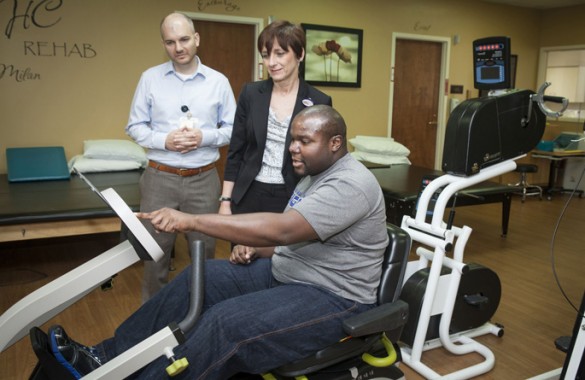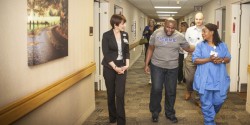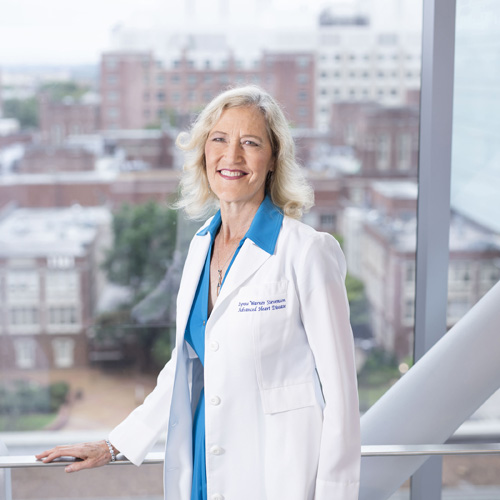
It’s May 8, 2014 — one year to the day since a 25-year-old homeless man, Kris Stevenson, was hit by a car while crossing the street in Nashville, resulting in severe brain, pelvic and abdominal injuries.
One year ago, Stevenson was dying on the trauma unit at Vanderbilt University Medical Center. Today he is walking and talking and receives a special visit from the people who helped with his incredible recovery.
Case manager Tanya Parrish, R.N., and social worker Josh Owens, LMSW, are part of Vanderbilt’s Transitions Program, which helps move patients from the hospital to home or another care setting. In Stevenson’s case, they worked with National HealthCare Corp. (NHC) to find him an appropriate skilled nursing facility.
Today, they have traveled two hours to NHC’s Milan, Tenn., facility to see how Stevenson has recovered and are amazed at the transformation.
“We weren’t sure he would improve, and thought he would probably be bed-bound and wheelchair-bound the rest of his life. I did not anticipate by any means that he would be up walking and talking,” Parrish said.
Stevenson is indeed walking and talking — and playing Xbox and Bingo, happily showing off his bedroom and the dining room and therapy room and introducing his visitors to all the staff who helped him, with a huge smile on his face.
“It was a challenge when I got here, but I made it. These people here and friends and family kept me going. I’m just taking it one day at a time,” Stevenson said.
The Transitions Program began in fall 2012 with the novel approach to pay for post-acute services for some uninsured patients on an as-needed, case-by-case basis. Often these uninsured patients remain at Vanderbilt when they could better recover at a skilled nursing facility or through home health.
“Staying in the hospital can lead to debilitation. The hospital gets you stabilized, and then we move you on to the right place,” Parrish said. “Kris is a great example of the transitions of care of a patient and how important it is to get them to the right place at the right time.”
NHC is a major partner in the Transitions Program, along with Kindred Healthcare, Sava Senior Care and Vanderbilt Stallworth Rehabilitation Hospital. More than 450 patients have benefited from the program to date.
Cathy Garrett, NHC director of Transition Networks, said that the partnership with Vanderbilt has developed in the last year, in large part because of the changes in the health care world.
“At one time, the care of someone like Kris would happen in a series of transitions, with only limited conversations between the health care providers. Now, NHC and Vanderbilt work regularly to identify the best places for patients to receive post-acute care and partner to ensure the best outcomes for those patients.

“In Kris’s case, our partnership has been regular for the past year, and the result is a life saved. This is a new approach that will only expand, and we are excited to be a part of it.”
Stevenson spent two weeks being stabilized in the Vanderbilt Trauma Unit following his accident, then was sent on a scholarship to Kindred Hospital Nashville, a transitional care hospital, to be weaned off the ventilator and to receive complex wound care for the severe wounds around his pelvis.
But he wasn’t recovering well and returned to Vanderbilt after two weeks. He was put on the Palliative Care Unit to receive comfort care and finally began to improve.
“We worked with his family in Memphis to get him the right level of care long-term. We weren’t sure how much better he would get, but we wanted to give him the chance to see what he could do,” Owens said.
With the potential that Stevenson could spend the rest of his life in a care facility, the Transitions Program team completed the paperwork for Medicaid and TennCare coverage.
“Our team is lucky to have scholarship as a tool to use, but we realized his needs were so great that he couldn’t accomplish what he needed in the constraints of a scholarship. This was the best, long-term option for him,” Owens said.
Becky Graves, director of nursing at NHC, Milan, was the first to see Stevenson’s referral.
“I knew it was a complicated case, but I remember saying, ‘We will fall in love with this kid.’ And we did.”
Stevenson arrived in Milan on July 15, and the rehab staff immediately began working with him.
“When I evaluated him, he was verbal but didn’t follow commands. He would not move his legs and if you tried to move them, he would scream,” recalled physical therapist Tonya Pigg. “But that first week I could see his quad muscle kicking in, and every week after he was showing more improvement.”
Stevenson took his first steps on Aug. 23 and never looked back.
“When I got here, I had an all black wheelchair. Then I graduated to an all silver wheelchair, then the walker, then all by myself. I graduated from speech therapy. I graduated from all of it. I got a T-shirt,” Stevenson said with a shy grin.
“He’s a miracle,” Pigg said. “At first we thought his goal would be on a walker. I didn’t think he could walk without assistance because you have to remember the head injury component of this. But in PT, we do a reassessment every two weeks. He was progressing every time and we would make new goals.”
The staff built a strong relationship with Stevenson. One of his favorite memories is the Christmas tree they decorated for him in blue, his favorite color, with Tennessee Titans and Memphis Grizzlies ornaments.
He built a special bond with certified nurse technician Bettie Fields, who got him his first pair of shoes once he started walking and cuts his hair every two weeks.
“I’ve never seen my mama, so she’s like the mama I never had,” Stevenson said. “She made sure I got my breakfast and clothes and put cream on my nose. She made sure I had the things I need.”
Parrish is still following Stevenson’s case and is working to get him an appointment in the Vanderbilt surgical clinic to evaluate reversing his colostomy. The NHC, Milan staff is working on the next step for Stevenson, possibly a group home setting with other patients his age.
“Our folks are going to be very picky in making sure he gets to the best place for him,” said Joseph Garst, administrator. “Kris was right up there with our most challenging cases, but our staff doesn’t shy away from it. They figure out what works for each person and that really makes a difference.”
Through the Vanderbilt Transitions Program and dedicated NHC staff, Stevenson is whole again and ready for whatever the future brings.
“A year ago we didn’t think he would be where he is today,” Owens said, “so I wouldn’t dare put a limit on where he could go.”














